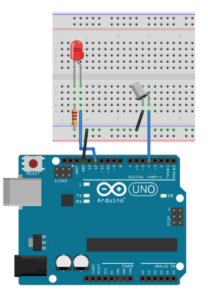byte ledPin = 13;byte switchPin = 3;void setup() {pinMode(ledPin, OUTPUT);pinMode(switchPin, INPUT_PULLUP);Serial.begin(9600); // Initialize serial communication}void loop() {if (digitalRead(switchPin) == LOW) {digitalWrite(ledPin, HIGH);Serial.println("1"); // Send "1" to indicate button pressed} else {digitalWrite(ledPin, LOW);Serial.println("0"); // Send "0" to indicate button not pressed}delay(100); // Add a small delay to avoid rapid serial communication}
Author: Ninj Tumurkhuyag
Final Project: Life Craft 2024
“Life Craft 2024”
Ninj Tumurkhuyag
Partner: Audrey
Professor: Eric Parren
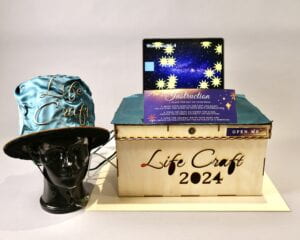
CONCEPT & DESIGN:
Our concept was to create an interactive game inspired by New Year’s resolutions, where players could collect words of affirmation for the upcoming year. Our preparatory research and essay led us to explore the concept of affirmations and the importance of setting positive intentions for personal growth. We wanted to create a playful and engaging experience that would encourage users to reflect on their goals and aspirations for the new year. In terms of user interaction, we initially decided to attach a tilt sensor to a controller board, allowing users to turn left and right to catch words of affirmation. However, during the User Testing Session, our professor Eric provided valuable feedback suggesting attaching the sensor to the head so we decided to create a hat and attach the tilt sensor to it. Users would then tilt their heads left and right to catch the words, creating a “thinking” action that added an extra layer of engagement to the game. To match the theme of New Year, we chose fabrics such as green silk for the hat and used green yarn to hide the wires attached to it. Additionally, based on feedback received during the User Testing Session, we decided to incorporate sound into the game and added background music and sound effects to make the gameplay more enjoyable. We also decided to set the background image as a galaxy, evoking a sense of shooting stars and wishes.
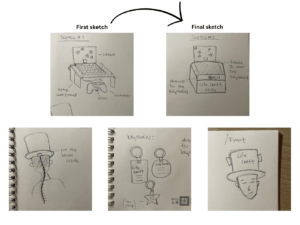
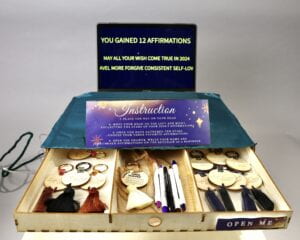
FABIRCATION & PRODUCTION:
During our production process, we encountered both failures and successes that shaped our final project. One of the significant steps was the decision to create multiple keychains for users to take home for more memorable and provide users with an evident reminder of their affirmations. However, we faced challenges with the code that was supposed to make the square contain the texts inside the stars. Then we changed it to display the collected affirmations at the end of the game instead. In terms of the sensors and actuators used in our project, we selected a tilt sensor as the primary device. The tilt sensor allowed users to control the movement in the game by tilting their heads and we chose this because it provided a hands-free and intuitive interaction method. As for other options, one possibility we considered was adding another player to the game. However, we rejected this option because our project’s primary focus was on personal reflection. During the coding process, our main goal was to ensure that the tilt sensor accurately detected movement and allowed users to catch the words. Once we made this function, we gradually added additional features such as sound effects and background. In terms of visuals, we designed and created a hat, drawers, and keychains to add a physical element to the game. These elements were crafted to match the theme of New Year’s and to provide users with tangible tokens to take home.
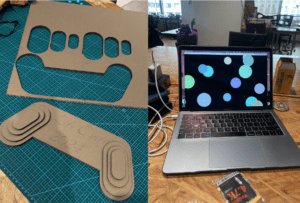

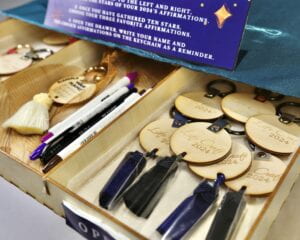
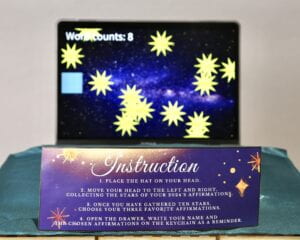
CONCLUSION:
The goals of our project were to create an interactive game inspired by New Year’s resolutions, encouraging people to reflect on their goals and aspirations for the upcoming year. We aimed to create a playful and engaging experience that would promote positive intentions and personal growth. During the IMA show, we saw that our audience interacted with the project, especially the kids, who enjoyed the physical and interactivity of the gameplay. Users actively tilted their heads to catch the words of affirmation, and the incorporation of sound effects and visuals enhanced their engagement. I think the results of our project align well with our definition of interaction, as users physically interacted with the tilt sensor. However, if we had more time, we would’ve liked to further refine the code that would make the square contain the texts inside the stars. Additionally, we could’ve added more varied affirmations to provide users with a wider range of positive messages. Through setbacks and failures encountered during the production process, we learned the importance of thorough testing and iterating on our design. In conclusion, our project successfully achieved its goal of creating an interactive game that encourages reflection and personal growth. We took valuable lessons from this course, and the way people played and enjoyed our game made us proud of the outcome of our project. Lastly, I’m very thankful for everyone, including our professors (from all sections), my dear partner Audrey, fellows, learning assistants, and other fellow students who helped and gave us good recommendations and feedback.
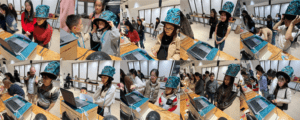
DISASSEMBLY:
We took this back to our dorms and cleaned the studio after every working session.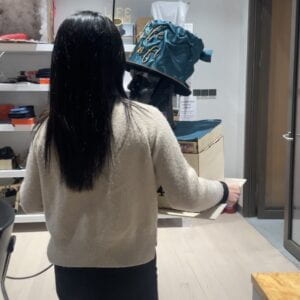
APPENDIX :
Arduino code + circuit Processing code
Sources:
Midterm project
Buzzer 07 / Ninj Tumurkhuyag / Eric Parren
Context and significance
During our previous group research project, we explored how we could make an object and materials that are not interactive to be interactive by acting it out, and it helped us, my partner, to come up with materials that can actually be interactive when it’s combined with other conductive materials. As I mentioned, the finished project from the research did not align with my definition of “interactive”, therefore I tried to come up with a project that allows the user to interact in ways such as touching, listening and seeing how their action impacts the project. However, because buzz-wire games are the games that everyone has played with or heard of, we tried to make ours more significant by making the wires flexible instead of being fixed. By doing this, we wanted to make the game a customisable experience as the shape can be changed depending on what “level”, easy or difficult, the players want to play with. Our project Buzz 07 is for everyone as it is designed for a wide range of individuals and is intended to be enjoyed by people of all ages and backgrounds. The inclusive qualities of the project ensure that it can be engaging and entertaining for children, teenagers, adults, and even older individuals.
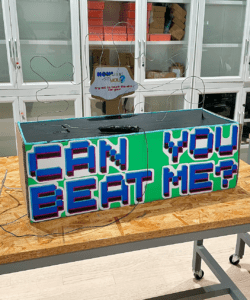
Concept and Design
When user testing, we found out people might require clear instructions to understand how the game works, even though we initially assumed the design would be self-explanatory. To clarify, I decided to include written instructions that would guide users through the gameplay process. Another design decision we made was related to the placement of the LED. We wanted people to focus on not touching the wires without any distractions so we placed a small red LED behind the wire rather than placing it in front of it.
Regarding the choice of materials and elements of the wire, as we received feedback on how the wires needed to be a bit thicker for more stability, we changed the wires to thicker wire but not too thick for flexibility because I think it adds an interactive element, enabling users to physically manipulate the wires.
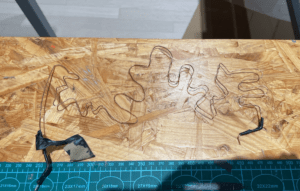
Fabrication and production
Firstly, we started by sketching out and discussing the design and materials we wanted to use for our project. This initial brainstorming phase helped us visualize the final product and set the foundation for our work. Next, we built a smaller demo version of the project to test the circuit and ensure that everything was working correctly. This step was crucial in identifying any technical issues or flaws in the design and it allowed us to make necessary adjustments and improvements before going further. Therefore, during the User Testing Session, we received a lot of feedback from users saying it was difficult to play and suggested making it larger and more stable. The feedback prompted us to reevaluate the size and stability of the wire and make solutions for the concerns.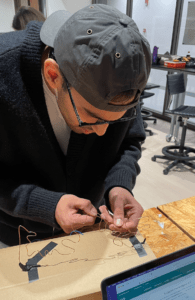
In terms of personal contributions, I took on the responsibility of coding, building the circuit, and working on the overall design and decoration of the project. I focused on ensuring that the code was working and responsive and that the circuit components were properly connected. I also worked on enhancing the aesthetic appeal of the game to make it visually appealing and engaging for users.
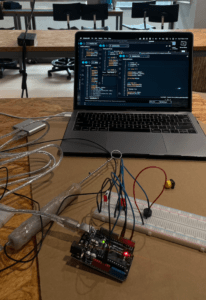
One of the major production choices we made was the inclusion of additional features such as a timer, speaker, and multiple LEDs. However, based on user testing feedback, we decided to streamline the game by including only one LED to avoid distracting users from the main objective. This decision was effective in simplifying the game and allowing players to focus on the core gameplay. Thus, we prioritised functionality over complexity and our main goal was to create a game that actually worked and provided an enjoyable user experience.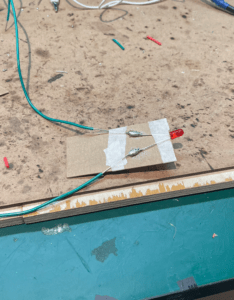
Coding:
int button = 2; int orangeLED = 6; int buzzer = 7; void setup() { pinMode (buzzer, OUTPUT); pinMode (orangeLED, OUTPUT); pinMode (button, INPUT); Serial. begin (9600); } void loop() { button = digitalRead (2); Serial.println(button); if (button == 1) { digitalWrite(6, HIGH); tone(buzzer,3000,700); } else { digitalWrite(6, LOW); noTone(buzzer); } }
Conclusion
In conclusion, the goals of our project, Buzz 07, were to create an interactive game that allowed users to touch, listen, and see how their actions impacted the gameplay. However, there were some aspects of our project that did not fully align with our definition of interaction. For example, we initially planned to include additional features like a timer, speaker, and multiple LEDs, but due to feedback from user testing, we decided to simplify the game and focus on the core gameplay experience. If we had more time, we would further refine the aesthetic design to make it visually appealing and engaging.
From setbacks and failures encountered during the production process, we have learned the importance of user feedback and the need to iterate and adapt based on that feedback. We successfully incorporated physical interaction, immediate feedback, and customization into the gameplay experience, aligning with our project goals. We also developed skills in coding, circuitry, and design, enhancing our abilities in creating interactive projects. While our project aligned with our definition of interaction in many aspects, there were areas where we had to make adaptations based on user feedback. Through this process, we learned valuable lessons and gained a deeper understanding of user preferences and the importance of iterative development.
Group research project
Title: Promox Nebluous 3000 Cyber Wing
Jennifer- The wing wearer Sara- The child Ninj- AI wing Leo- Narrator 1 Jess - Narrator 2/Staff/Citizens Sara - Staff/Mother/Citizens Scene: 1 In Omelas Narrator 1: “This is Jenny, she’s a happy citizen in a happy place, Omelas.” Jenny waves. “Here in Omelas, everyone is happy.” Jenny walking around. Jenny: “Hey, Eric, Andy and Gottfried! What’s up guys?” Citizen 1: Good morning, Jenny! Another beautiful day in Omelas, isn’t it?” Jenny: “It sure is! The sun is shining, and everyone seems so content.” Citizen 2: “Have you tried the new ProMax Nebulous 3000 Cyber? It's amazing!” Jenny: “I have! It's like having a personal assistant and more.” Narrator 1: “Recently, the citizens of Omelas have gotten their hands on a new piece of technology. Take a look at the ProMax Nebulous 3000 Cyber, our incredible wing.” The wing moves up and down. “In Omelas, people don’t need Didis because of this. It has transformed the lives of its citizens, offering multifunctional wings that serve as their all-encompassing aides, seamlessly integrating into every facet of their existence.” Pause. “Jenny’s mother comes to see her.” Mother: “Jenny! You’re finally eighteen. I know how much you wanted to see the child and now you finally can!” Jenny: “My mom says that our happiness depends on the suffering of a child…” Prepares to go through the door Scene: 2 In the Basement Jenny Goes through the door, into the basement Narrator 2: “As Jenny steps into the basement, a stinky smell welcomes her. The dimly lit room is small, uncomfortable, and most certainly not suitable for life.” Jenny: “Ew. What is this smell? Why is this place so dark? How can it be so small?” AI Wing: “Unhealthy air condition, unhealthy air condition, this place is not sanitary, leave immediately” Scene 3: Meeting the child Jenny: “But I want to explore more…” Walks around and bumps into the child. AI Wing: “Child detected, Child detected.” Jenny: “That’s the child?” AI Wing: “Obviously” Jenny walks up to the child, the child won't speak “Why is this child so sad? She looks very miserable…” Child (whispering): “Help me...” Jenny: "Oh I see it now... the price of our happiness." AI Wing: "Indeed, Jenny. The cost of our utopia is a heavy one." Narrator 2: “The wings, sensing Jenny's torn feelings of empathy and the desire to stay in Omelas, begin to activate regardless.” The wings, sensing Jenny's feelings of empathy, begin to activate. Jenny: “But I don't want to leave…” AI Wing: “But is that fair for the child? According to my moral programming, it is unethical to let the child suffer, even though everyone in Omelas is happy, but based on my calculations and databases, the best thing to do is to make everyone leave.” AI Wing starts to lift Jenni and flies away, the people flying away. Jenny: “But is it fair for the wings to sacrifice the happiness of everyone else?!” Screams and flies away Citizens: The citizens also start flying away “Where are we going?? What is happening?? The wings are doing their own thing!” Narrator 1: The child gets up and walks out to see the world. “The child finally leaves the basement and she finally can explore the world of happiness. The end.” THE END
Visual Metaphor
Meet me at, Ninj and David
CONCEPT & STORY:
Our main concept was the feeling of nostalgia and missing someone. The storyline is about how the two characters are doing the same actions but in different settings and environments. They are not together but they have a strong connection between them that makes them meet each other at the end.
We were inspired by the short film “Kingyo” by Edmund Yeo. The reason why we were inspired by the film and decided to make our own version of a short film is simply because it gave us the feeling that something is missing and the theme was not too bright nor too dark yet aesthetic in its own unique way. Therefore we decided to make it a bit more unusual or interesting, we decided to not show our full body and instead only shoot our legs walking around places.
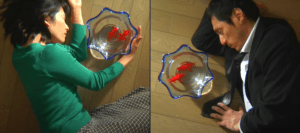
Kingyo by Edmund Yeo
CREATION PROCESS & EXECUTION:
In our first storyboard, our original idea was to place our video that side by side in split-screen, but it made it seem like we were comparing those two characters’ life therefore we instead placed each scene one after the other. Creating the storyboard, made it easier for us to film our scenes as it contained the basic information of where to film and what angle to use. Since both of us were amateurs, we used our phones to record our film as we both agreed that filming on the phone will be easier to record movements and bring them with us to different locations. 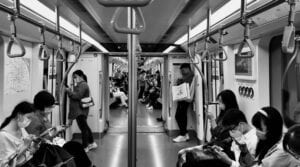
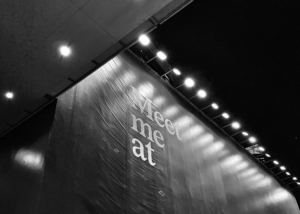
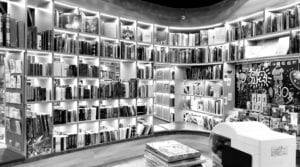
locations
And because most of the scenes we shot were in public space, it was difficult for us to film at the right time. We took at least 10 shots for each scene to get the perfect shot because we were keep getting disturbed by people walking over, metro leaving and having a tilt in the video. But however, after trying for many shots, we figured out how and when to film and improvised our filming skills in public. I also think recording the narration was challenging as it was in Korean, and though we were going to add subtitles, we wanted to deliver the meaning and the message with my voice and the pace of my reading. Which made us record the narration over and over to get the perfect one.
During the editing process, we tried many different ways of placing each scene to ensure the storyline was clear to the audience. We not only focused on de-noising our narration audio n audition but also worked hard on the colour grading in premier-pro in order to make the videos which were shot in different areas with different lighting mixed with each other. Because and fortunately the theme of our film did not require any use of effects like special effects and visual effects, we only worked on the placement, added subtitles, did colour-grading, and edited audio so that they go well.
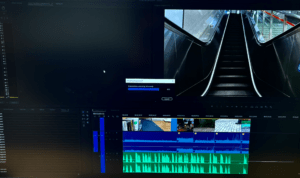
COLLABORATION:
As I also mentioned in our visual metaphor proposal, we divided our work equally and I think the work we did was really teamwork. Everyone in IMA who took or taking the communications lab course at the moment told me your “partner” matters a lot because there were many students whose partners were doing nothing and ended up doing their project alone. Hence, I think I was lucky to work with my dear partner and friend David because we understood each other very well during the whole process of making our final project. We listened to each other very well but also commented on how we each thought about each other’s ideas and suggestions.
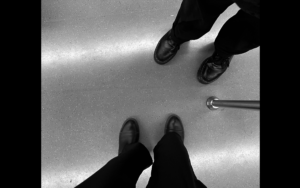
David and Ninj
I also felt grateful for Day for helping me record my or our audio. Though he did not speak Korean, he did a really great job of giving suggestions and tutoring me on how to fully express our narration in a way that matches the overall theme of our short film and I want to thank him for being such an understanding yet supportive partner and great friend during my freshmen year. Among all the new things I have learned from my partner was to focus even on the tiny details. When working with Day, I noticed he pays attention to every single detail of his work while editing and it was my first time seeing someone who pays more attention to small details than me so it was nice to have him as my partner.
AESTHETICS & RESULTS:
As the aesthetic and overall theme we chose to go with our final project was nostalgia and gloom, we colour-graded our film with mostly green and blue hues to give it a “feeling of blue”. However, at the end of our film, the ending scene, we decided to give it a bit of liveliness by adding orange and warm tones because our two characters meeting each other meant warmth and love.
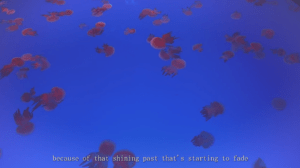
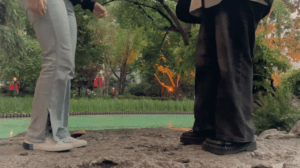
Project Title: “No title yet”
Team Members: David and Ninj
1). What is the piece (article, poem, story) for the narrative voice-over? Or who are you going to interview? – We will narrate our own story in Korean or Spanish, as we’ve already built our storyline.
2). What’s the story about? – The story is about how the two main characters live in the same timeline but keep barely missing each other by one step, and end up meeting each other to show everything has its timing. Though the characters had the chance to bump into each other, they never do, because they were destined to meet each other at the end as perfect timing.
3). Which part of the story are you going to focus on? – Our main focus will be the ending of the story where two characters finally meet each other and how the split screens turn into one frame and one scene.
4). What kind of style/aesthetics are you going to pursue? – We will be using the split-screening technique, while also colour-grading each scenes differently to express that the time is passing.
- Execution Plan:
1). What equipment are you going to use when shooting the movie? – We will be using both a DSLR camera and phone camera as well as a microphone (tascam), stabilizer and tripod.
2). Which locations will it be shot at? When is it? Daytime/night/unknown? Why? – Daytime at school, metro, office – to show the time is passing. For example from high schoolers to office workers.
3). What are some challenges you might encounter and how will you prepare? – We think our main challenge will be the editing part as we will be using split screens. Therefore, we went through a lot of short films and videos that use the split-screening technique as well as tutorial videos.
4). How will you collaborate? How will you divide work? – We will mostly work together on editing. I don’t think dividing our work will be beneficial for our project as we need our opinion and help from each other on every step of the process.
Storyboard draft: 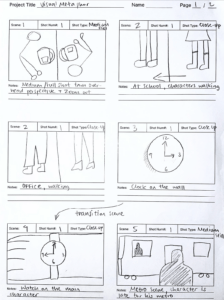
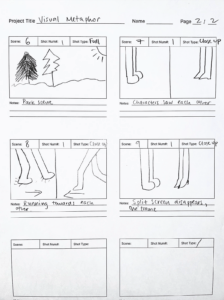
Reverse storyboard: Parasite
Parasite scene 1:21:00
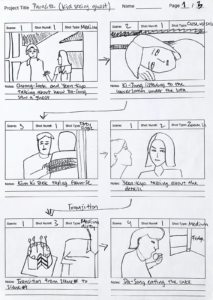
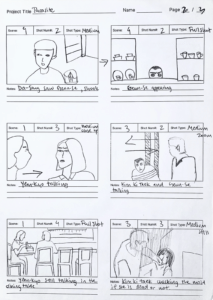
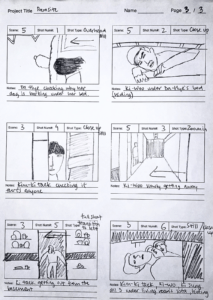
Memory Soundscape
The Concept:
The project was inspired by the sounds and feelings I have heard and felt on the first night I’ve spent in the hotel for quarantine after landing in China. As I was overwhelmed with all the thoughts of me having to live in a foreign country without my family, and having the anxiety of not wanting to test positive for each quarantine tests, I tried to express those combination of feelings by layering mulitple recordings. Turning a memory into a soundscape was not an easy process as the term of “memory” is more close to abstract idea, and I didn’t want my soundscape to be simple and clear, but wanted it to be a bit more abstract, I used sounds such as water drops and shaking beads to represent the sound of a fast beating and anxious heart beats of mine. And to as I also wanted to add the feeling of eeriness, I added effects on some of the layers, also to add dimension to my memory soundscape.
The Process:
To list all the sounds I’ve used in my project:
- shaking beads, knocking, stovetop, water drop1, water drop2, water drop3, necklace chain, bottle cap dropping, guitar, seed cracking, vitam C tablets fizzing, shoes sweeping, turning book pages, keyboard sounds and tearing paper sound.
As I mentioned I didn’t want to recreat the actual sounds I’ve heard while staying at the hotel, I wanted to play with different sounds that didn’t actually related to my memory. However, after recording many unrelated sounds, I’ve realised all the recordings were not going well together smoothly. Therefore, to not make it too abstract, I rerecorded and added recordings of water drops, that differs from one another, to make the audiences listen and feel how quiet yet noisy the hotel was. The opening and the ending of my project was what I think the most focus went into, because I thought having an edgy start that catches people’s attention while also having tight ending was crucial. To do this, I used a guitar’s low E note and reversed it to make it sound like it is a beginning of a journey because it was the beginning of my memory. And for the ending, I used the recording of a page tearing audio to give an impression of the journey has come to an end because I’ve teared the page.
To me, the process of editing, combining and layering the audios was actually fun and the most interesting part of the whole project. I had all the sounds I’ve needed to create my memory, so I enjoyed while struggling to have to smoothest transformation of each recordings. The only challenging thing was how my drafts sounded unusual on different speakers and even headphones. But by fixing the parts that needed the volume to be lowered or boosted and adding a little touch ups, I got the result I was expecting for the final one. One of the lessons I’ve learned while editing the sounds is how small edits and touch ups can make up a huge difference in recordings and the more you spend time by adding details, the more the recordings get combined and blend to each other evenly.
The Conclusion:
I am overall very happy with my memory soundscape project, and since it had to be only 60 seconds, even if I had more time I wouldn’t have did anything because sometimes, simple is the best! But if I still had to fix something, it would be me adding up more unique audios and make the transitions more smooth.
During the presentation, it was interesting to hear how my fellow classmates have perceived my project. Some got my intention right, of how it sounded creepy and like a starting of a sci-fi film, while some said it could be about gambling because of the coin dropping sound… And as everyone observe a certain information all differently it is hard to make the meaning behind your art work clear to all. However, based on their feedbacks, I could’ve focused more on layering the recordings.
The Image:
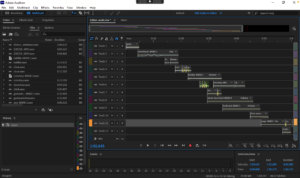
- Response to “The Uncertainty of Documentarism” by Hito Steyerl.
Steyerl’s theory of how the “unbroken belief” of the documentary form is being challenged is how it has stopped corresponding to reality and has become abstract. In other words, Steyerl states in the article that in the past, it was only considered a form of the documentary if the document had captured something clear and visible, while the change has made the abstractness or the uncertainty of how the document represents something can also convey the truth.
For example how those CNN images still acutely express the uncertainty of the real world even though the images are all low resolution and could only see patterns of something green and brown moving across the screen. “The closer to reality we get, the less focused and jumpier the images become.
Nowadays I think it is really difficult to differentiate the reliabilities and inaccurate news and content because of the highly developing technologies. For instance, an image of the former president of the united states, Donald Trump getting arrested created by an AI has caused a lot of buzz on many social media platforms. In fact, I myself believed the false image until I checked the comment section. Therefore, compared to other media such as articles or images, live broadcasts bring trustworthy information.
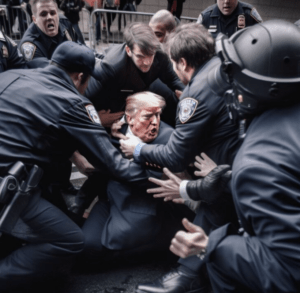 created by Eliot Higgins using Midjourney v5.
created by Eliot Higgins using Midjourney v5.
2. Five Obstructions (2004) by Jorgen Leth & Lars von Trier
The rules of each obstruction are simple:
#1 It must be shot in Cuba and each sets and shots have to be shorter than 12 frames.
#2 It should be shot in the worst place to shoot a film
#3 It should be made with Leth’s freedom of style
#4 It should be a cartoon
#5 It should be re-created by von Tier
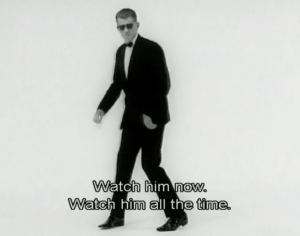
Though Danish director Jorgen Leth was challenged to remake The Perfect Human, the way Leth go back and forth from Cuba to India, Belgium to the U.S. and stopped at Denmark to show it to von Trier shows how committed he was to refilm the original film. In the film, von Trier said “This isn’t a competition with yourself, this is therapy” to Leth, and this brings out von Trier’s intention with his project with Jorgen. Indeed, when it comes to filmmaking, I think people should have in their mind that there’s no right or wrong and should always challenge themselves to try new methods. The same goes for Leth, von Trier’s goal was not to make Leth’s film a great remake of The Perfect Human, but to observe the process of filmmaking more like a “therapy”.
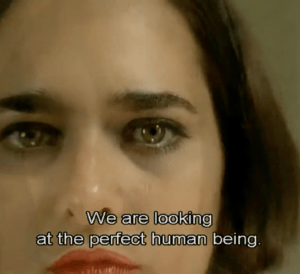
The first remake observing the first obstruction in Cuba was fun to watch as Leth had the limitation of only using 12 frames as it also added a bit of rhythm and humanity as it contained Cuban culture. For the second one, I enjoyed watching Leth himself being the performer and part of his artwork. The third, the one that was the most different in the style compared to von Trier’s original one shows how two artists in the same art field can differ when making art. Then, the fourth one was my favourite of all the 5 obstructions as it had to be an animation. Although the message or theme an animation and film deliver differs, it was interesting to see a short film recreated as a cartoon. The last, and the most meaningful obstruction kind of gave me the impression of two artists sharing knowledge or just simply uniting with filmmaking as a bridge. 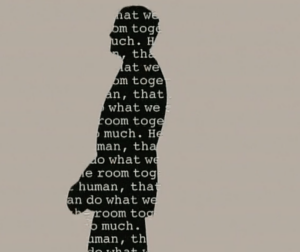
As a person who enjoys watching behind-the-scenes videos of films, it was almost fascinating when I watched this documentary film for the first time. It not only made me learn all the processes of filmmaking but also made me understand that exploring the limitless possibilities of cinematography is more important to stick to a certain rule and there is still a lot to be exposed in the film industry.
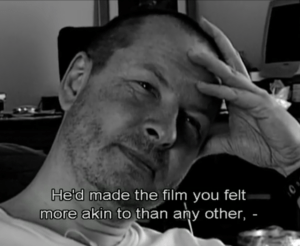 Img from “Five Obstructions” (2004) by Jorgen Leth and Lars von Trier, taken from Kanopy.
Img from “Five Obstructions” (2004) by Jorgen Leth and Lars von Trier, taken from Kanopy.
Memory
It was when I spent the first night at the hotel of the quarantine after I landed in China. Because it was my first time so far away from my home, without any of my family members, I was overwhelmed with all the emotions I felt. The loneliness, excitement, scariness and mostly the homesickness. I was quarantined in Guangzhou and probably not the central part of the city because it was usually pretty quiet, which actually made me even more lonely.
I remember the feeling of having to stay in this unfamiliar place, where people spoke a different language, scared me the most. Because it was such a hot day, I decided to take a shower while thinking of what to do for the next 9 days. And because I was not used to the new and odd Chinese dishes, I cooked ramen for my dinner.
I also remember I was not being able to figure out how to connect my phone to the wifi so I stuck there for the whole night in total silence. Well, as there is no such thing as silence, I heard water dripping from the shower head in the toilet as well as mopeds passing by the building and the AC blowing at its highest frequency. Nothing made me miss home so much that I cried myself to sleep, only to wake up by the sound of something like a coin dropping but went back to sleep because I was too afraid to think about what will happen next.
